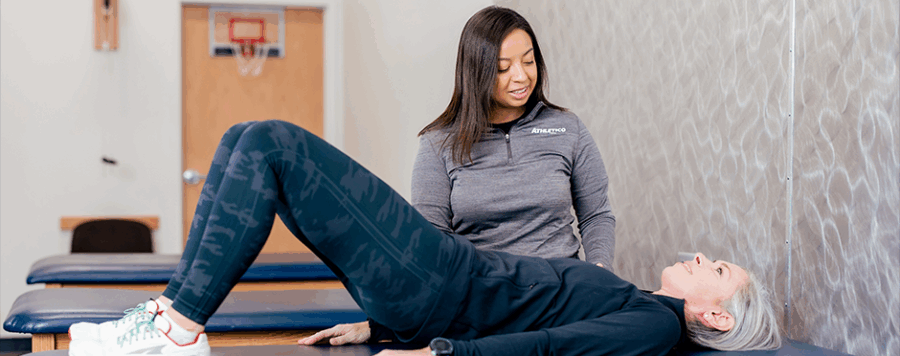1. What is pelvic health?
Pelvic health physical therapy involves treatment around the pelvis, and almost always, a group of muscles inside the pelvis called your pelvic floor. Don’t get me wrong, any thorough therapist will look at the person as a whole, but this is a specific focus on the land down under. Some people wonder if only cisgender women have pelvic floors – absolutely not! We all have pelvic floors, and their functions are super important to our health. The pelvic floor is a group of muscles, like a hammock, that attach from your tailbone in the back of your body to the pubic bone in the front of your body.
2. Why is our pelvic floor so important?
We talk about its functions as the 5 “S’s”.
- Support. It supports our pelvic organs against gravity and abdominal pressure.
- Sphincter control. These muscles wrap around and control the openings of your bladder and rectum.
- Stability. They are a very important part of our “core,” just like your abdominals.
- Sex. They help with arousal and orgasm.
- Sump pump. These muscles contract and lift to help circulate blood and lymph throughout the pelvic floor and back to the heart.
3. How do you contract your pelvic floor muscles?
Pelvic floor contractions, or Kegels, work like a bicep curl where you engage the muscle and then let the muscle relax. We like to discuss the pelvic floor like an elevator: You first need to close the elevator doors and then take the elevator to the third floor. This means we need to squeeze in and then lift up. We should not be bearing down/pushing down on the pelvic floor. This type of contraction is called straining and could actually cause problems.
Coordination is also an important part of using it properly. If you find yourself holding your breath to perform a Kegel, try taking a deep breath to relax and then exhaling, and you squeeze and lift your pelvic floor muscles. This exhale facilitates a contraction of the muscles up and in, while the inhale helps your pelvic floor expand down and out to relax.
4. What about urinary leakage? Is this normal?
No, this is not a normal issue to deal with just because you have had a baby! Leakage is common but abnormal and can often be improved without extra procedures or medications.
The first type we will speak about is stress incontinence. This is when we leak urine during activities such as coughing, laughing, jumping, running, etc. Improving the coordination of your pelvic floor contraction (like we discussed above) and maintaining an exercise program can significantly improve stress leakage. Several studies have shown that after three months of Kegel training, one-third of the women had been fully cured, and two-thirds had improved. We recommend three sets of 10 daily at a minimum. Also, the good news is that they can be done anywhere, like sitting at the dinner table, brushing your teeth, or lying in bed. So, let’s get those Kegels done!
5. Let’s talk about urgency and urge incontinence
This is when you go to the bathroom an excessive number of times a day and/or you leak on the way to the bathroom with a full bladder. The normal number of trips to the bathroom is between 6-8 x daily. Kegels can be helpful in this situation, but a urination schedule is the most effective. The muscles in the bladder signal to the brain when it is full, and this system can become disrupted if we pee too often or too little. This is why we advise against the “just in case pees” and putting yourself on a schedule to pee every 3-5 hours; sometimes this can be challenging. If you struggle and need help learning urge suppression techniques or have other diagnoses that may make frequent urination harder to overcome, see an Athletico PT for an evaluation and care.
If your issues extend beyond what we’ve covered, please seek professional assistance from your local pelvic health physical therapist. We can provide relief for urine leakage, pelvic pain, and many other issues. Get started by contacting your nearest Pelvic Health Therapist today!
Find a Pelvic Health Therapist Near You
The Athletico blog is an educational resource written by Athletico employees. Athletico bloggers are licensed professionals who abide by the code of ethics outlined by their respective professional associations. The content published in blog posts represents the opinion of the individual author based on their expertise and experience. The content provided in this blog is for informational purposes only, does not constitute medical advice and should not be relied on for making personal health decisions.
References:
1. Raizada V, Mittal RK. Pelvic floor anatomy and applied physiology. Gastroenterol Clin North Am. 2008 Sep;37(3):493-509, vii. doi: 10.1016/j.gtc.2008.06.003. PMID: 18793993; PMCID: PMC2617789.
2. Bary Berghmans, Maura Seleme. The ‘5 F’s Concept for Pelvic Floor Muscle Training: From Finding the Pelvic Floor to Functional Use. Journal of Women’s Health and Development 3 (2020): 131-134.
3. Marcellou EG, Stasi S, Giannopapas V, Bø K, Bakalidou D, Konstadoulakis M, Papathanasiou G. Effect of pelvic floor muscle training on urinary incontinence symptoms in postmenopausal women: A systematic review and meta-analysis. Eur J Obstet Gynecol Reprod Biol. 2025 Jan;304:134-140. doi: 10.1016/j.ejogrb.2024.11.040. Epub 2024 Nov 26. PMID: 39615241.
4. Mohamed, Hanan Gaber et al. “EFFECT OF PELVIC FLOOR MUSCLE STRENGTHENING-KEGEL’S EXERCISE- ON SEVERITY OF STRESS URINARY INCONTINENCE AND QUALITY OF LIFE AMONG WOMEN.” (2018).
5. Urinary frequency in community-dwelling women: what is normal? Lukacz, Emily S. et al. American Journal of Obstetrics & Gynecology, Volume 200, Issue 5, 552.e1 – 552.e7

 width="900"
height="356"
>
width="900"
height="356"
>
